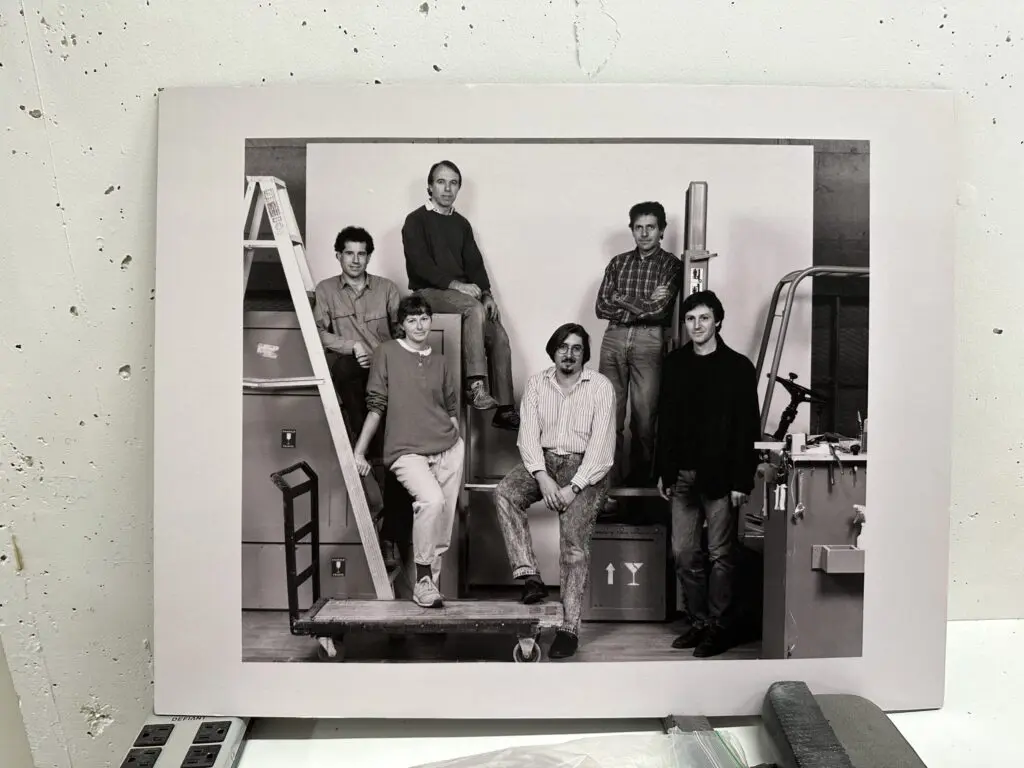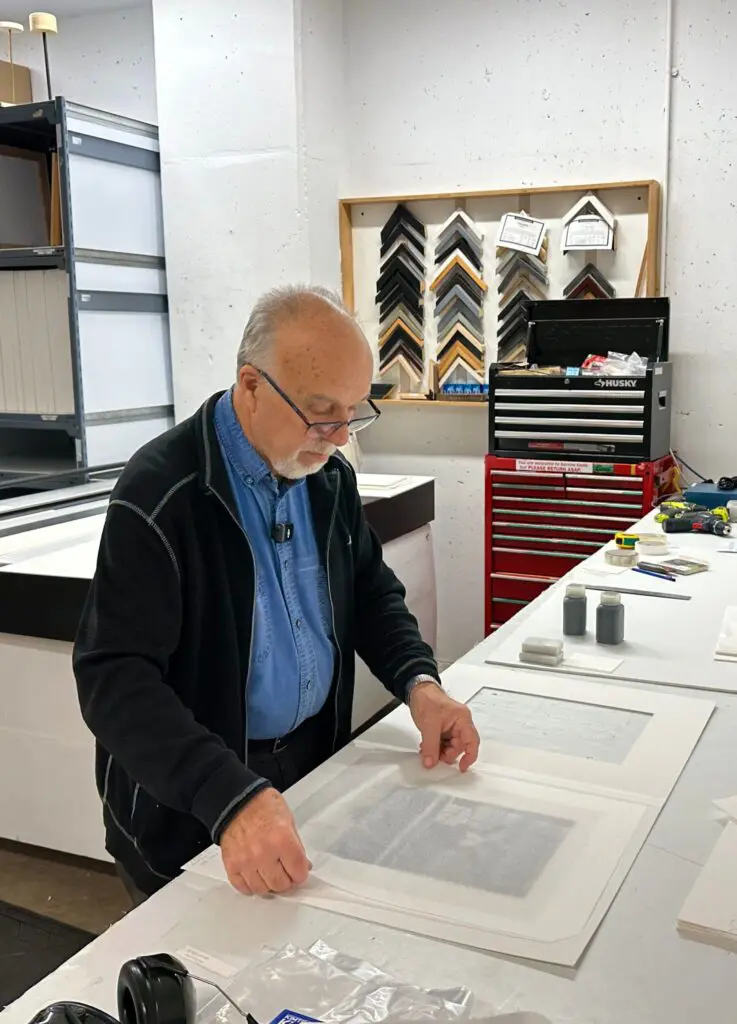Staff Profile: Michael Trevillion
Meet Michael Trevillion, a skilled framer and expert art handler who has been with the Gallery for over forty years!
We asked Mike to share more about his role—preparing artworks for exhibitions, maintaining the permanent collection and ensuring pieces are displayed with care. With decades of experience, spanning the Gallery’s original home at 1145 West Georgia Street to its present location, Mike has witnessed the Gallery’s evolution firsthand.

Michael Trevillion in the Matting & Framing Workshop, 2025
Please tell us a little bit about your role at the Gallery and the work that you do.
Michael Trevillion (MT): My role at the Gallery has come full circle. I was originally hired by the Vancouver Art Gallery for my matting and framing skills, having worked solely in that capacity at the Winnipeg Art Gallery for the previous five years. However, the Gallery’s Preparation Department at that time was very small, so we shared the responsibilities equally. Consequently, my work consisted of not just matting and framing, but also art installation, lighting, mount making, crate and plinth building, as well as various other carpentry projects. However, as the department grew, my activities focused more and more on matting and framing until it is now again my central responsibility.
As matter and framer, I work closely with the Conservation Department, ensuring that artworks are adequately protected. For works on paper, this usually entails mounting the work in a 100% rag mat before framing for exhibition or storing in solander boxes and print drawers in the vault. Most of these works are either recent acquisitions or are works slated for an upcoming exhibition. However, we also have an ongoing, multi-year project of gradually matting the many hundreds of works on paper in our collection that are still unmatted.
How long have you worked at the Gallery?
MT: I started work at the Gallery in January 1982, so I am closing in on forty-three years. The first twenty months were at the old Vancouver Art Gallery, situated at 1145 West Georgia Street, where the Paradox Hotel (formerly Trump Tower) now stands.
Can you tell us a bit more about the significance of an artwork’s frame? Why would one work be framed and another not?
MT: Artworks are usually framed for visual considerations and for protecting the artwork. The visual considerations may include separating the artwork from the surrounding wall area, drawing the viewer into the artwork, tying several artworks together with the same type of frame, or placing more than one work in a single frame. Conversely, some works are better displayed without a frame, especially some paintings on canvas or a solid substrate, as the artist may wish for the painting not to feel closed in. However, a frame can protect an artwork and allow for ease of handling, transporting and hanging. This is especially true of works on paper that require a frame (and usually a mat) to accommodate protective glazing in front of the work.
What does your day-to-day work at the Gallery entail?
MT: A typical day usually entails an initial meeting with the rest of the Preparation crew as we coordinate activities for the day, especially during an exhibition install period. I then may also confer with the Conservation Department. Often times I can work independently if I am involved in an ongoing project. If there are framing requests for the current exhibition install or deinstall, they usually are the priority. Otherwise, the matting and framing of recent acquisitions usually proceeds. When the schedule allows, I also tackle the ongoing matting of the many unmatted works on paper in our collection. As well, Conservation may request upgrades for specific mats or frames. One area I am involved in is the upgrading of frames that house important works on canvas—such as Emily Carr and the Group of Seven artists—so that they can accommodate anti-reflective glazing and a spacer between the glazing and the canvas. This often entails a partial rebuilding of the frame.

Vancouver Art Gallery Preparation Department staff, c. 1985, with Michael Trevillon pictured top left
What are some of your early memories of working at the Gallery?
As mentioned earlier, I first worked at the old Gallery, where there was a much smaller staff. Coffee breaks were very unifying in that pretty well the whole Gallery staff could fit into the tiny staff lounge. It was a very involving period, as we worked not only on current exhibitions but also readying the collection for the big move to the new Gallery. The attendance at the old Gallery was quite sparse. We moved to the new Gallery in September 1983, which dramatically changed our fortunes, our attendance and our visibility in the public eye.

Michael Trevillion in the Matting & Framing Workshop, 2025
In your over 40 years at the Gallery, what has been one of your favourite exhibitions? Was there a particularly interesting or unique frame that you worked on?
Many of the most challenging frames have been very large. The largest has been a frame for a Shuvinai Ashoona work displayed in her exhibition here in 2020. Most frame moldings are no longer than ten feet in length, so we had to get a frame molding specially milled for this work. Assembling the frame, along with oversized Plexiglas, retainer and spacer, was challenging but ultimately very satisfying.
Other rewarding framing experiences include upgrading or restoring frames that reflect the period in which the work was painted. This often entails matching the original colour, profile and finish of a frame.
There have of course been many exhibitions that I’ve enjoyed over the past four decades, both as a viewer and as an installer. As a viewer, I was particularly drawn to historical exhibitions, such as the Tom Thomson exhibition in 2002, the Lawren Harris exhibition in 2014 and especially the Dutch Masters, works from the Rijksmuseum exhibition in 2005. As an installer, I particularly valued the exhibitions where we had to innovate, such as the Massive Change exhibition in 2004.
The most memorable and satisfying exhibition to install, however, was Down from the Shimmering Sky in 1999. It was our first major exhibition of First Nations masks, collected from museums throughout North America and Europe. Most of these masks needed mounts in order to be displayed. We brought in a well-respected mount maker from Seattle for a month who taught three of the Preparators (myself included) how to fashion mounts from brass, using oxy-acetylene torches and silver solder. We worked through many days and evenings fashioning these mounts. It was a very satisfying experience and has been an invaluable skill that we still employ and have passed on to two more Preparators since.
Thinking back on your time at the Gallery, what has been one of your most memorable experiences here?
Probably the most memorable experience has to be the actual move into this building in 1983, when we installed exhibitions simultaneously on all four floors, readying the Gallery for its grand re-opening. There were lots of late evenings when everyone, including the Director, helped to hang works. At the same time, we were also busy building work tables, benches and art-transport dollies downstairs in the carpentry shop. It was an exciting few months!
